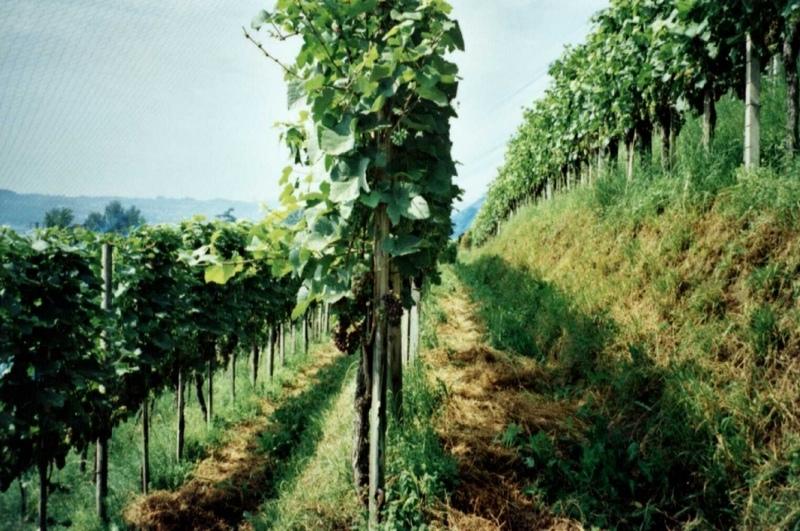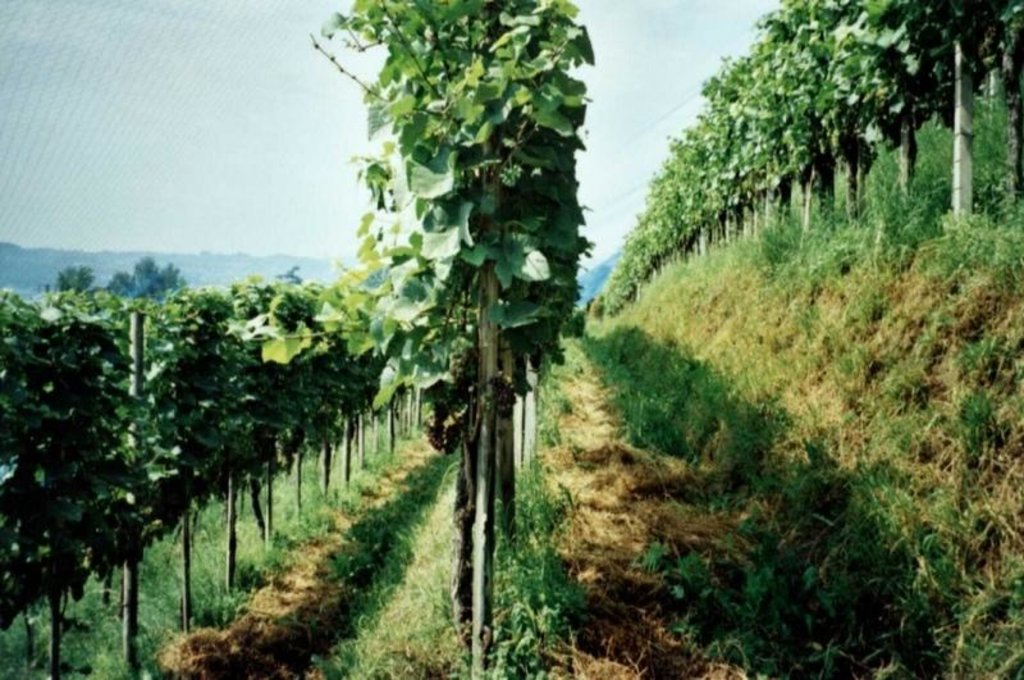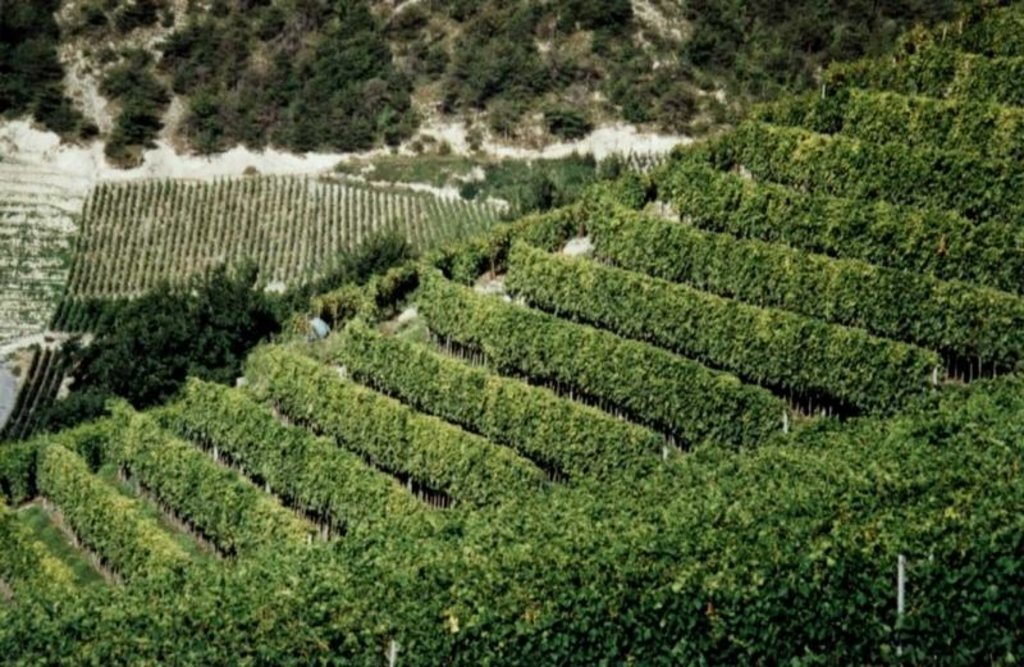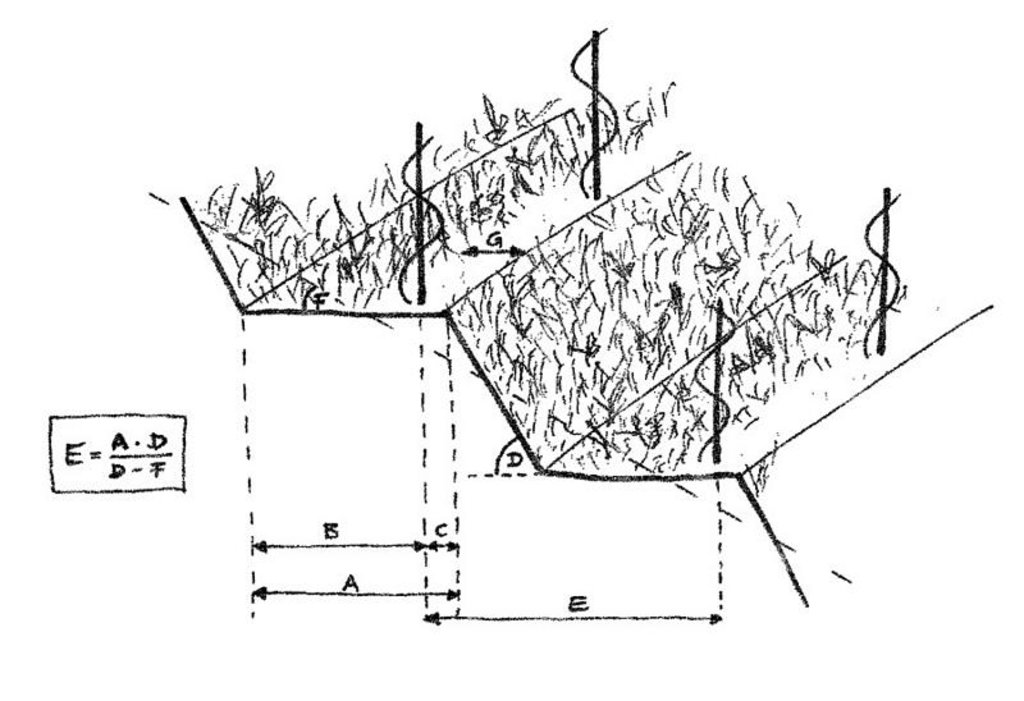Contour small bench terraces with permanent green cover in vineyards [瑞士]
- 创建:
- 更新:
- 编制者: Nicole Guedel
- 编辑者: –
- 审查者: Fabian Ottiger, Alexandra Gavilano
Ganzjährig begrünte Kleinterrassen im Rebbau
technologies_1011 - 瑞士
查看章节
全部展开 全部收起1. 一般信息
1.2 参与该技术评估和文件编制的资源人员和机构的联系方式
SLM专业人员:
Weissenbach Peter
Federal Research Station for fruit-growing, viticulture and horticulture-FAW
瑞士
SLM专业人员:
Spring Jean-Laurent
Federal Research Station for fruit-growing, viticulture and horticulture-RAC
瑞士
土地使用者:
Louis Hannes
Louis Weinbau
瑞士
土地使用者:
Hasler Lukas
Hasler Weinbau
瑞士
有助于对技术进行记录/评估的机构名称(如相关)
Federal Research Station for fruit-growing, viticulture and horticulture (FAW/RAC) - 瑞士有助于对技术进行记录/评估的机构名称(如相关)
CDE Centre for Development and Environment (CDE Centre for Development and Environment) - 瑞士1.3 关于使用通过WOCAT记录的数据的条件
编制者和关键资源人员接受有关使用通过WOCAT记录数据的条件。:
是
1.5 参考关于SLM方法(使用WOCAT记录的SLM方法)的调查问卷
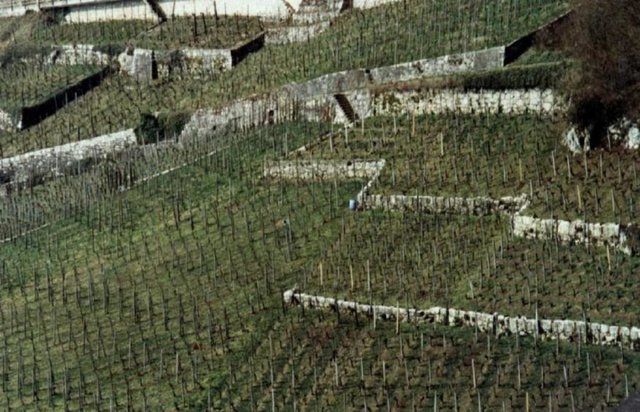
Farmer initiative within enabling environment [瑞士]
Initiative and innovation of land users, stimulated by government's technical and financial support.
- 编制者: Nicole Guedel
2. SLM技术的说明
2.1 技术简介
技术定义:
Contour small bench terraces with stabilising permanent green cover in steep sloping vineyards.
2.2 技术的详细说明
说明:
Description: The vineyards of the region are all, for micro-climatc reasons, more or less sloped. The technology is applied on steep to very steep slopes. It ist characterised by two elements: 1) small bench terrace with one contour-oriented vine row per terrace and 2) an initially sown all-year green cover of the soil surface for stabilisation reasons (green cover is also used between vine rows which are oriented up and down the slope, eg not terraced, see SWI01).
Purpose: Main purpose of the terrace construction is a possible mechanisation on steep to very steep slopes. Direct purpose of the green cover is the stabilisation of the small terraces, indirect but important purpose is the prevention of soil degradation, especially soil erosion by water and - secondary - to protect soil surface from compactation when using mechanised equipment.
Establishment: The terraces are constructed by external specialists and heavy machinery (walking excavator, type "Menzi Muck") and are considered to serve for a whole life cycle of the vine (20-40 years). The green cover is sown since stabilisation is needed from the very beginning on. The duration of the establishment is 3 years. Because of insufficient root length of young vines agronomic and vegetative measures differ from the "normal" measures: For reasons of competition the space around the freshly planted vines is kept free from vegetation with a hoe.
Maintenance: the topsoil is ripped from time to time with fuel driven machine (spade machine tracked by tractor). Cover vegetation is either cut or chopped and serves as mulching . Herbicides are applied around the vines. Minimum tillage and cutting / mulching may additionally serve to mobilise nutrients and to increase organic matter content or to eliminate competition of cover vegetation.
Natural environment: the vineyards are mainly placed on mountain or hill slopes, below 600 m a.s.l., annual rainfall is around 1000 mm with at least one erosive storm per year. The geological underground is limy, locally layered by Molasse (type of conglomerate). Soil properties are strongly influenced by anthropogenic activities (viticulture). Main degradation problem without green cover is erosion by water.
Human environment / land use: the region has a strong wine growing tradition (several centuries), belongs to the important Swiss wine growing regions and is not very densly populated.
First experiments with green cover in Switzerland were done in the 70ies around Zürich on contour small bench terraces, in the region of the lake of Biel contour small bench terraces with green cover started to be implemented in the 80ies
2.3 技术照片
2.5 已应用该技术的、本评估所涵盖的国家/地区/地点
国家:
瑞士
区域/州/省:
Canton of Berne
有关地点的进一步说明:
Lake of Biel
注释:
The technology is applied in all winegrowing regions of Switzerland, but under different conditions.
2.6 实施日期
如果不知道确切的年份,请说明大概的日期:
- 不到10年前(最近)
2.7 技术介绍
详细说明该技术是如何引入的:
- 通过项目/外部干预
注释(项目类型等):
The development of contour small bench terraces with green cover in vineyards was (also on the international level) essentially promoted and supported by the Federal Research Station for fruit-growing, viticulture and horticulture in Wädenswil (Canton of Zürich) and Changins (Canton of Vaud)
3. SLM技术的分类
3.2 应用该技术的当前土地利用类型

农田
- 乔木与灌木的种植
乔木和灌木种植 - 指定作物:
- 葡萄
每年的生长季节数:
- 1
具体说明:
Longest growing period in days: 210Longest growing period from month to month: Apr - Oct
注释:
Major land use problems (compiler’s opinion): The main problem was decreasing soil fertility, especially throug soil erosion by water with negative off-site effects like sand- /sediment deposition and contamination of groundwater by nutrients. It became a serious problem since the 60ies when the fact became visible that the traditional labour-intensive cultivation system, which was strongly dependent on external inputss, could no longer be sustained within an industrialised agriculture system.
Type of cropping system and major crops comments: a vine plantation is established for a period of 20-40 years (lifetime of a vine). Some farmers make one year of fallow between the destruction of the old and the establishment of a new plantation.
3.4 供水
该技术所应用土地的供水:
- 混合雨水灌溉
注释:
Water supply: rainfed, mixed rainfed - irrigated
3.5 该技术所属的SLM组
- 改良的地面/植被覆盖
- 横坡措施
- Stabilisation of terraces
3.6 包含该技术的可持续土地管理措施
3.7 该技术强调的主要土地退化类型

土壤水蚀
- Wt:表土流失/地表侵蚀
- Wo:场外劣化效应

化学性土壤退化
- Cn:肥力下降和有机质含量下降(非侵蚀所致)
- Cp:土壤污染

物理性土壤退化
- Pc:压实
- Pk:熟化和结壳
注释:
Main type of degradation addressed: Wt: loss of topsoil / surface erosion, Wo: offsite degradation effects
Secondary types of degradation addressed: Cn: fertility decline and reduced organic matter content, Cp: soil pollution, Pc: compaction, Pk: sealing and crusting
Main causes of degradation: other human induced causes (specify) (agricultural causes: fast changing basic conditions of viticulture in the last 100 years), education, access to knowledge and support services (lack of knowledge), fast changing basic conditions of viticulture (economy, laws)
3.8 防止、减少或恢复土地退化
具体数量名该技术与土地退化有关的目标:
- 减少土地退化
注释:
Main goals: mitigation / reduction of land degradation
4. 技术规范、实施活动、投入和成本
4.1 该技术的技术图纸
技术规范(与技术图纸相关):
Technical drawing of small contour bench terraces with permanent green cover. A = width of terrace, B = tractor area, C = distance between vine plant and terrace edge, D = gradient of terrace riser, E = distance of vine rows, F = orignal slope, G = zone of application of herbicides (10-40 cm).
Date: June 2003
Technical knowledge required for field staff / advisors: high
Technical knowledge required for land users: moderate
Main technical functions: control of dispersed runoff: retain / trap, reduction of slope angle, reduction of slope length, improvement of ground cover
Secondary technical functions: control of raindrop splash, increase of surface roughness, increase in organic matter, increase of infiltration, increase / maintain water stored in soil, improvement of soil structure, increase in soil fertility
Mulching
Material/ species: cut or chopped cover vegetation
Remarks: dispersed over the whole surface; if possible cutting/chopping (alternating)
Agronomic measure: removing less vegetation cover
Material/ species: cut or chopped cover vegetation, vine leaves and cut branches
Remarks: between vine rows
Manure / compost / residues
Material/ species: compost
Remarks: only sporadically (every 5-10 year or less)
Mineral (inorganic) fertilizers
Material/ species: nitrogen
Quantity/ density: 0-50 kg/ha
Remarks: normally rather little nitrogen
Agronomic measure: mineral (inorganic) fertilizers
Material/ species: potassium
Quantity/ density: 0-20 kg/ha
Agronomic measure: mineral (inorganic) fertilizers
Material/ species: magnesium
Quantity/ density: 0-25 kg/ha
Agronomic measure: mineral (inorganic) fertilizers
Material/ species: phosphorus
Quantity/ density: 0-20 kg/ha
Breaking compacted subsoil
Remarks: only on terrace, if possible only every second row/terrace (alternating)
Scattered / dispersed
Vegetative material: G : grass
Grass species: different grass species, taraxacum, veronica, legumes, calystegia, geranium...
Terrace: bench level
Vertical interval between structures (m): 1.3 m
Spacing between structures (m): 2.5 m
Construction material (earth): only earth of parcel
Slope (which determines the spacing indicated above): 60%
Lateral gradient along the structure: 0%
Vegetation is used for stabilisation of structures.
作者:
Nicole Güdel, Berne, Switzerland
4.3 技术建立活动
| 活动 | 时间(季度) | |
|---|---|---|
| 1. | sowing cover vegetation on the terrace riser (for stabilisation) (nonrecurring) | winter/spring, usually at the same time as a new plantation is established |
| 2. | letting grow natural cover vegetation on terrace (nonrecurring) | winter/spring, usually at the same time as a new plantation is established |
| 3. | Removing vegetation around vines (diameter of vegetation-free zone: 10 - 40 cm) | during season (Mai – October), 2 - 4 times, when necessary. |
| 4. | removing old vines | winter/spring |
| 5. | deep tillage | winter/spring |
| 6. | construction of terraces | winter/spring |
| 7. | support of construction of terraces | winter/spring |
4.4 技术建立所需要的费用和投入
注释:
Duration of establishment phase: 36 month(s)
4.5 维护/经常性活动
| 活动 | 时间/频率 | |
|---|---|---|
| 1. | cuting and not removing vine leaves and branches | winter / annual |
| 2. | fertilising (mineral or manure/compost) | April/May / annual |
| 3. | cutting / chopping and then mulcihng cover vegetation | during cropping season (first time April/May) / each row 2-4 times during cropping season |
| 4. | cuting and not removing vine leaves and branches | during cropping season / several times during cropping season |
| 5. | breaking compacted topsoil | April/May / each row every 4-8 years |
| 6. | application of herbicides (glyphosates) | beginning of season (May), if necessary second time in Aug./Sept /once (if necessary twice) during s |
| 7. | putting back earth which war fallen from the terrace riser to the terrace | winter/spring/if necessary |
| 8. | slightly reshaping terraces | winter/spring/if necessary |
4.6 维护/经常性活动所需要的费用和投入(每年)
注释:
Machinery/ tools: e.g.: walking excavator, hoe, mower with tracked vehicle or portable motor scythe, spading machine with tracked vehicle; knapsack sprayer or biocide t
4.7 影响成本的最重要因素
描述影响成本的最决定性因素:
(manual) labour
5. 自然和人文环境
5.1 气候
年降雨量
- < 250毫米
- 251-500毫米
- 501-750毫米
- 751-1,000毫米
- 1,001-1,500毫米
- 1,501-2,000毫米
- 2,001-3,000毫米
- 3,001-4,000毫米
- > 4,000毫米
有关降雨的规范/注释:
Average: Biel: 1200 mm. Region of Bielersee: 1000 - 1200 mm. Neuchâtel: 930 mm.
农业气候带
- 半湿润
Thermal climate class: temperate
5.2 地形
平均坡度:
- 水平(0-2%)
- 缓降(3-5%)
- 平缓(6-10%)
- 滚坡(11-15%)
- 崎岖(16-30%)
- 陡峭(31-60%)
- 非常陡峭(>60%)
地形:
- 高原/平原
- 山脊
- 山坡
- 山地斜坡
- 麓坡
- 谷底
垂直分布带:
- 0-100 m a.s.l.
- 101-500 m a.s.l.
- 501-1,000 m a.s.l.
- 1,001-1,500 m a.s.l.
- 1,501-2,000 m a.s.l.
- 2,001-2,500 m a.s.l.
- 2,501-3,000 m a.s.l.
- 3,001-4,000 m a.s.l.
- > 4,000 m a.s.l.
关于地形的注释和进一步规范:
Altitudinal zone: 501-1000 m a.s.l. (For climatic reasons vines grow hardly above 600 m a.s.l. in Switzerland)
Landforms: Hill slopes (most of them southeastward sloping hills (part of the Jura mountain range))
Slopes on average: Steep (31-60%) (Vines are planted on different slopes. But contour small bench terraces are applied at steep slopes)
5.3 土壤
平均土层深度:
- 非常浅(0-20厘米)
- 浅(21-50厘米)
- 中等深度(51-80厘米)
- 深(81-120厘米)
- 非常深(> 120厘米)
土壤质地(表土):
- 中粒(壤土、粉土)
表土有机质:
- 中(1-3%)
如有可能,附上完整的土壤描述或具体说明可用的信息,例如土壤类型、土壤酸碱度、阳离子交换能力、氮、盐度等。:
Soil depth: From shallow to very deep (Soil depth is very irregular, at some places limestone rocks appear at the surface, at other places soil can be quite deep.But if soil is very shallow for the whole parcel contour small bench terraces)
Soil fertilits is medium (Vines are normally grown on rather marginal spots. Compared to the general productivity these soils have a medium fertility. (If measured at the vine itself, soil fertility is sufficient/high))
Topsoil organic matter is medium (loamy,silty) (without / before SWC (green cover))
Soil drainage/infiltration is mostly good, at some spots medium (depressions; when high percentage of clay)
Soil water storage capacity is medium (without / before SWC (green cover)), high (without / before SWC (green cover)) or low (without / before SWC (green cover). Depressions; when high percentage of clay)
5.6 应用该技术的土地使用者的特征
生产系统的市场定位:
- 商业/市场
非农收入:
- 低于全部收入的10%
相对财富水平:
- 平均水平
机械化水平:
- 手工作业
- 机械化/电动
说明土地使用者的其他有关特征:
Population density: 200-500 persons/km2
Annual population growth: 0.5% - 1%
Off-farm income specification: This is representative for the full time winegrowers. The majority of winegrowers do winegrowing beside a regular off-farm job as a hobby. Nearly all winegrowers have implementeted the SWC technology. Probably there is no difference in hobby-winegrowers and full-time-winegrowers concernring implementation of the SWC technology.
Level of mechanization: Manual labour (most of the work in the vineyard is done by hand (especially harvest)) or mechanised (some of the activities are carried out with fuel driven equipment. But mechanisation is moderate since big and heavy machines cannot been applied in these vineyards).
Market orientation is commercial/market (in the region of the lake of Biel the majority of grapes are pressed to wine an then and sold directly from the farm's wine cellar)
5.7 应用该技术的土地使用者使用的平均土地面积
- < 0.5 公顷
- 0.5-1 公顷
- 1-2 公顷
- 2-5公顷
- 5-15公顷
- 15-50公顷
- 50-100公顷
- 100-500公顷
- 500-1,000公顷
- 1,000-10,000公顷
- > 10,000公顷
注释:
Average area of land owned or leased by land users applying the Technology: 0.5-1 ha, 1-2 ha, 2-5 ha, 5-15 ha (only winegrowing land!)
5.8 土地所有权、土地使用权和水使用权
土地所有权:
- 个人,有命名
土地使用权:
- 个人
6. 影响和结论性说明
6.1 该技术的现场影响
社会经济效应
生产
作物生产
注释/具体说明:
maximum production capacity is reduced due to 1. Plantation density is smaller and 2. Capacity per vine is reduced due to slight competition of water and nutrients, intensified in the terrace riser under dry conditions
作物质量
注释/具体说明:
Reduced quality of wine occurs when strong competition of water and nutrients happen and nothing is done against it.
生产故障风险
注释/具体说明:
Higher susceptibility to fungal decay due to higher evapotranspiration rate with green cover and therefore humid microclimatic conditions. Other problems are competition over water and nutrients or danger of frost - negligible - only in depressions or plains (due to higher evapotranspiration rate)
收入和成本
农业收入
注释/具体说明:
Primarily due to less costs, especially resulting from less erosion damages in the long term (because of green cover). Secondary due to marketing argument "ecological agricultural production", subsidies related to green cover (direct payment which is only
工作量
注释/具体说明:
More and specific knowledge necessary
其它社会经济效应
Inputs for mechanisation
注释/具体说明:
Special machines needed, mechanisation is almost a must to be economically successful in the long term
社会文化影响
健康状况
注释/具体说明:
Healthier than without SWC, less application of biocides and more comfortable and healty posture of body.
社区机构
注释/具体说明:
Increased exchange of knowledge and contacts in winegrowers society
国家机构
注释/具体说明:
Research stations gained new knowledge and attention
SLM/土地退化知识
注释/具体说明:
Among winegrowers, but perhaps also slightly among consumers (through an ecological marketing argument) or walkers (walking through a green vineyard may arise interest in green cover).
冲突缓解
注释/具体说明:
Between generations or between farmers applying green cover and others. Reason: farmers are differently attached to traditional values and norms (i.e.: traditionally every plant was seen as unuseful weed and fought with a hoe).
Personal satisfaction / challenge
注释/具体说明:
Many farmers apply green cover see green cover as a personal satisfaction or challenge for an ecologically and economically sustainable viticulture
Acceptance by society
注释/具体说明:
Landscape and appearance of Landscape & appearance of vineyard as cultural heritage. Different values an norms of "how a vineyard should look like". Traditionally vines were planted very dense with no vegetation cover in between. Contour small bench terraces are quite new to the area (20-30 years)
生态影响
土壤
土壤水分
注释/具体说明:
Especially through improved water retention capacity (due to improved soil structure)
土壤覆盖层
土壤流失
注释/具体说明:
Mainly due to green cover (rather than terraces)
土壤压实
生物多样性:植被、动物
外来入侵物种
注释/具体说明:
Undesirable plant and animal species (i.e. mice (can hamper stability of terrace riser and terrace itself))
害虫/疾病控制
注释/具体说明:
Through beneficial animals
减少气候和灾害风险
风速
其它生态影响
Biodiversity
注释/具体说明:
High diversity due to different habitats (extensively managed terrace riser and terrace)
Soil fertility
6.2 该技术的场外影响已经显现
下游洪水
下游淤积
地下水/河流污染
风力搬运沉积物
6.4 成本效益分析
技术收益与技术建立成本相比如何(从土地使用者的角度看)?
短期回报:
非常消极
长期回报:
中性/平衡
技术收益与技术维护成本/经常性成本相比如何(从土地使用者的角度看)?
短期回报:
轻度消极
长期回报:
中性/平衡
6.5 技术采用
在所有采用这项技术的人当中,有多少人是自发的,即未获得任何物质奖励/付款?:
- 91-100%
注释:
10% of land user families have adopted the Technology with external material support
Comments on acceptance with external material support: estimates
90% of land user families have adopted the Technology without any external material support
Comments on spontaneous adoption: estimates
There is a strong trend towards spontaneous adoption of the Technology
Comments on adoption trend: Contour small bench terraces with green cover are seen as good opportunity for viticulture in steep slopes. Adoption is done mainly spontaneous
7. 参考和链接
7.1 信息的方法/来源
链接和模块
全部展开 全部收起链接

Farmer initiative within enabling environment [瑞士]
Initiative and innovation of land users, stimulated by government's technical and financial support.
- 编制者: Nicole Guedel
模块
无模块


